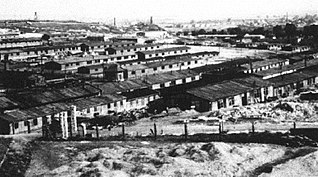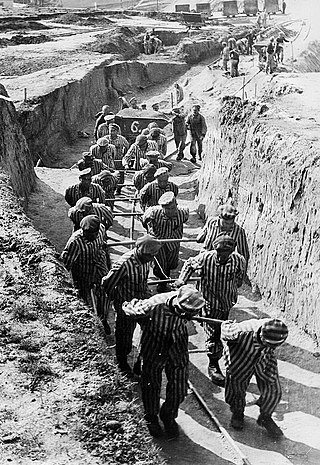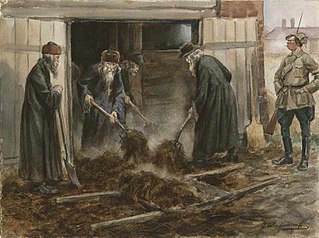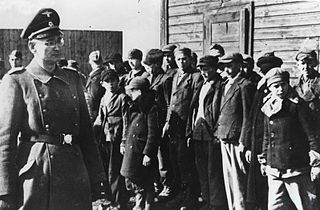
Nazi Germany used six extermination camps, also called death camps, or killing centers, in Central Europe during World War II to systematically murder over 2.7 million people – mostly Jews – in the Holocaust. The victims of death camps were primarily murdered by gassing, either in permanent installations constructed for this specific purpose, or by means of gas vans. The six extermination camps were Chełmno, Belzec, Sobibor, Treblinka, Majdanek and Auschwitz-Birkenau. Extermination through labour was also used at the Auschwitz and Majdanek death camps. Millions were also murdered in concentration camps, in the Aktion T4, or directly on site.

Organisation Todt was a civil and military engineering organisation in Nazi Germany from 1933 to 1945, named for its founder, Fritz Todt, an engineer and senior member of the Nazi Party. The organisation was responsible for a huge range of engineering projects both in Nazi Germany and in occupied territories from France to the Soviet Union during the Second World War. The organisation became notorious for using forced labour. From 1943 until 1945 during the late phase of the Third Reich, OT administered all constructions of concentration camps to supply forced labour to industry.

A labor camp or work camp is a detention facility where inmates are forced to engage in penal labor as a form of punishment. Labor camps have many common aspects with slavery and with prisons. Conditions at labor camps vary widely depending on the operators. Convention no. 105 of the United Nations International Labour Organization (ILO), adopted internationally on 27 June 1957, abolished camps of forced labor.

The German camps in occupied Poland during World War II were built by the Nazis between 1939 and 1945 throughout the territory of the Polish Republic, both in the areas annexed in 1939, and in the General Government formed by Nazi Germany in the central part of the country (see map). After the 1941 German attack on the Soviet Union, a much greater system of camps was established, including the world's only industrial extermination camps constructed specifically to carry out the "Final Solution to the Jewish Question".

From 1933 to 1945, Nazi Germany operated more than a thousand concentration camps, including subcamps on its own territory and in parts of German-occupied Europe.

Forced labour, or unfree labour, is any work relation, especially in modern or early modern history, in which people are employed against their will with the threat of destitution, detention, or violence, including death or other forms of extreme hardship to either themselves or members of their families.

Lager Sylt was a Nazi concentration camp on Alderney in the British Crown Dependency in the Channel Islands. Built in 1942, along with three other labour camps by the Organisation Todt, the control of Lager Sylt changed from March 1943 to June 1944 when it was run by the Schutzstaffel - SS-Baubrigade 1 and Lager Sylt became a subcamp of the Neuengamme concentration camp .
Lager Helgoland was a labour camp on Alderney in the Channel Islands, named after the Frisian Island of Heligoland, formerly a Danish and then British possession located 46 kilometres (29 mi) off the German North Sea coastline and belonging to Germany since 1890.

Extermination through labour is a term that was adopted to describe forced labor in Nazi concentration camps whose inmates were held in inhumane conditions and suffered a high mortality rate; in some camps most prisoners died within a few months of incarceration. In the 21st century, research has questioned whether there was a general policy of extermination through labor in the Nazi concentration camp system because of widely varying conditions between camps. German historian Jens-Christian Wagner argues that the camp system involved the exploitation of forced labor of some prisoners and the systematic murder of others, especially Jews, with only limited overlap between these two groups.

Arbeitseinsatz was a forced labour category of internment within Nazi Germany during World War II. When German men were called up for military service, Nazi German authorities rounded up civilians to fill in the vacancies and to expand manufacturing operations. Some labourers came from Germany but exponentially more from roundups in the German-occupied territories. Arbeitseinsatz was not restricted to the industry sector and to arms producing factories; it also took place, for example, in the farming sector, community services, and even in the churches.

The Soldau concentration camp established by Nazi Germany during World War II was a concentration camp for Polish and Jewish prisoners. It was located in Działdowo, a town in north-eastern Poland, which after the Nazi-Soviet invasion of Poland in September 1939 was annexed into the Province of East Prussia.

During World War II, Nazi birthing centres for foreign workers, known in German as Ausländerkinder-Pflegestätte, Ostarbeiterkinderpflegestätten, or Säuglingsheim were German institutions used as stations for abandoned infants, Nazi Party facilities established in the heartland of Nazi Germany for the so-called 'troublesome' babies according to Himmler's decree, the offspring born to foreign women and girls servicing the German war economy, including Polish and Eastern European female forced labour. The babies and children, most of them resulting from rape at the place of enslavement, were abducted en masse between 1943 and 1945. At some locations, up to 90 percent of infants died a torturous death due to calculated neglect.

Ostarbeiter was a Nazi German designation for foreign slave workers gathered from occupied Central and Eastern Europe to perform forced labor in Germany during World War II. The Germans started deporting civilians at the beginning of the war and began doing so at unprecedented levels following Operation Barbarossa in 1941. They apprehended Ostarbeiter from the newly-formed German districts of Reichskommissariat Ukraine, District of Galicia, and Reichskommissariat Ostland. These areas comprised German-occupied Poland and the conquered territories of the Soviet Union. According to Pavel Polian, although the Ostarbeiter from most occupied territories were predominantly men, of the "eastern workers" taken from occupied Soviet territories over 50% were women, and of those from Poland nearly 30% were women. Eastern workers included ethnic Ukrainians, Poles, Belarusians, Russians, Armenians, Tatars, and others. Estimates of the number of Ostarbeiter range between 3 million and 5.5 million.

Polish decrees, Polish directives or decrees on Poles were the decrees of the Nazi Germany government announced on 8 March 1940 during World War II to regulate the working and living conditions of the Polish workers (Zivilarbeiter) used during World War II as forced laborers in Germany. The regulation intentionally supported and even created anti-Polish racism and discrimination on the grounds of ethnicity and racial background.

In the years following World War II, large numbers of German civilians and captured soldiers were forced into labor by the Allied forces. The topic of using Germans as forced labor for reparations was first broached at the Tehran conference in 1943, where Soviet premier Joseph Stalin demanded 4,000,000 German workers.

Military brothels were set up by Nazi Germany during World War II throughout much of occupied Europe for the use of Wehrmacht and SS soldiers. These brothels were generally new creations, but in the west, they were sometimes expansions of pre-existing brothels and other buildings. Until 1942, there were around 500 military brothels of this kind in German-occupied Europe, serving travelling soldiers and those withdrawn from the front. According to records, a minimum of 34,140 European women were forced to serve as prostitutes during the German occupation of their own countries along with female prisoners of concentration camp brothels. In many cases in Eastern Europe, teenage girls and women were kidnapped on the streets of occupied cities during German military and police round ups called łapanka in Polish or rafle in French.

Heuaktion was a World War II operation in which 40,000 to 50,000 Polish children aged 10 to 14 were kidnapped by German occupation forces and transported to Nazi Germany as slave labourers.
German Equipment Works was a Nazi German defense contractor with headquarters in Berlin during World War II, owned and operated by the Schutzstaffel (SS). It consisted of a network of requisitioned factories and camp workshops across German-occupied Europe exploiting the prisoner slave labour from Nazi concentration camps and the Jewish ghettos in German-occupied Poland. DAW outfitted the German military with boots, uniforms and materials on the eastern front at a windfall profit, and provided wood and metal supplies, as well as reconstruction work on railway lines and freight trains.

The occupation of Poland by Nazi Germany and the Soviet Union during World War II (1939–1945) began with the Invasion of Poland in September 1939, and it was formally concluded with the defeat of Germany by the Allies in May 1945. Throughout the entire course of the occupation, the territory of Poland was divided between Nazi Germany and the Soviet Union (USSR), both of which intended to eradicate Poland's culture and subjugate its people. In the summer-autumn of 1941, the lands which were annexed by the Soviets were overrun by Germany in the course of the initially successful German attack on the USSR. After a few years of fighting, the Red Army drove the German forces out of the USSR and crossed into Poland from the rest of Central and Eastern Europe.

Forced labour was an important and ubiquitous aspect of the Nazi concentration camps which operated in Nazi Germany and German-occupied Europe between 1933 and 1945. It was the harshest and most inhumane part of a larger system of forced labor in Nazi Germany.


























